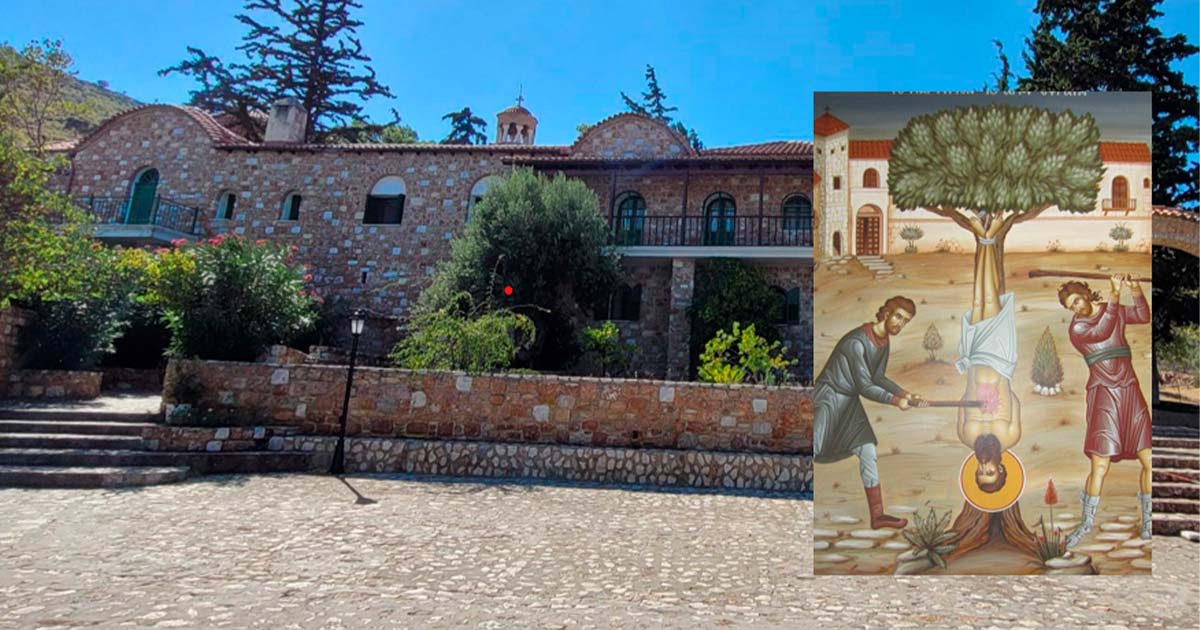The Tragic History of Saint Ephraim Monastery in Greece
Situated in Nea Makri, Attica, the Saint Ephraim Monastery stands as a significant landmark showcasing Greece’s historical and spiritual lineage. While originally called the Annunciation of the Theotokos on Mount Amomon, it is better known for its connection to Saint Ephraim, whose life was brutally cut short. Established in the early 14th century, the monastery serves as a vivid reminder of the area's religious past, featuring tales not only of spirituality but also of suffering and unwavering faith in the face of extreme adversity.
Founding and Early Years
While the exact date remains a matter of academic debate, it is widely accepted that the Saint Ephraim Monastery was established in the first half of the 14th century. Its location in Nea Makri, a strategic point in Attica, made it a focal point for religious activities. Designed in the traditional Byzantine style of the period, the monastery was not just a center for spiritual pursuits but also a bastion of learning and theological studies.
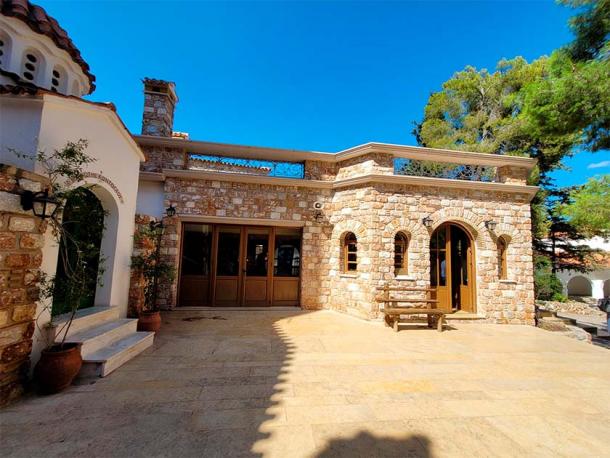
Saint Ephraim Monastery, Nea Makri, Greece. Photo: Joanna Gillan
Who Was Saint Ephraim?
Saint Ephraim, originally known as Konstantinos Morfis, was born on 14 September 1384 AD in Trikala, near the river Lithaeos, Ephraim's early life was marred by tragedy. With his father's untimely death, his mother was left to single-handedly care for their eight children. The shadow of the Ottoman Empire loomed large over Greece, and at the tender age of 14, Ephraim, to escape the fate of being conscripted into Ottoman military and being converted to Islam, found refuge in the monastery on the Mount of Amomon.
In the confines of the monastery, Ephraim was drawn to the monastic life. Amidst the walls of the monastery, his faith and commitment to God flourished. This sanctuary, however, would soon be rattled by the surging power of the Ottoman Empire. In 1416, Attica succumbed to Ottoman aggression, and the Duke of Athens had no choice but to cede control to the Sultan.
The year 1424 marked a dark chapter for the monastery. Ottoman forces, in their relentless drive, descended upon the monastery, ruthlessly slaughtering its monks. At the time, providence had taken Saint Ephraim away from the monastery to his prayer cave, sparing him from the massacre. But his reprieve was short-lived. Barely a year later, in September 1425, the Ottomans returned. They captured and subjected Ephraim to excruciating torture. For months, he endured unspeakable pain until his final moments on 5 May 1426. In a brutal display, the Ottomans hanged him upside down from a mulberry tree and impaled him with a burning stick. Through it all, Saint Ephraim's faith remained unwavering, sealing his legacy as a martyr and beacon of resilience.
- The Violent Birth of ‘Martyrdom’ – How the Ancient Concept Informs Modern Religious Violence
- Six Supremely Sadistic Deaths of Christian Martyrs
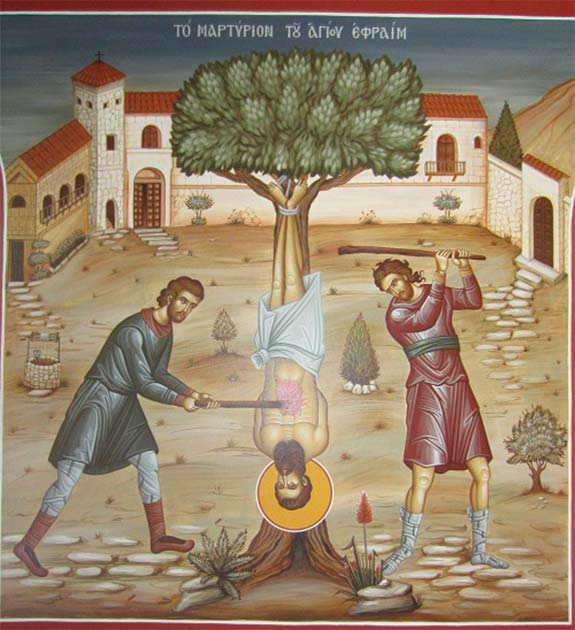
The brutal murder of Saint Ephraim. Source: Full of Grace and Truth Blogspot
Relics Rediscovered
The monastery, despite the tragic events of 1424, remained a place of spiritual importance. Its significance was further heightened in 1950 when a devout nun named Makaria made a miraculous discovery. Allegedly directed by visions of Saint Ephraim, Makaria unearthed the buried relics of the saint from the monastery grounds.
In 1945, Sister Makaria had been drawn to the sacred ruins of the monastery where she built a small room (cell) for herself and lived in devotion to her faith. On 3 January 1950, guided by a divine impulse, Sister Makaria asked a worker to dig in a specific spot on the grounds. At that specific point he unearthed the ruins of a fireplace, a wall, and items that indicated that exactly there used to be a monk’s cell (room). It was among these ruins, that the remains of Saint Ephraim were found. She unearthed his body and placed it in a case over the tomb. According to the story, that night Saint Ephraim appeared to her in a vision, revealing his name. He asked for his body to be removed from the case. The next morning the nun took the holy relics from the case, cleaned them and put them in a small slot in the Church. Saint Ephraim’s holy relics have been held there since and hundreds of faithful people visit daily asking for his help and blessings.
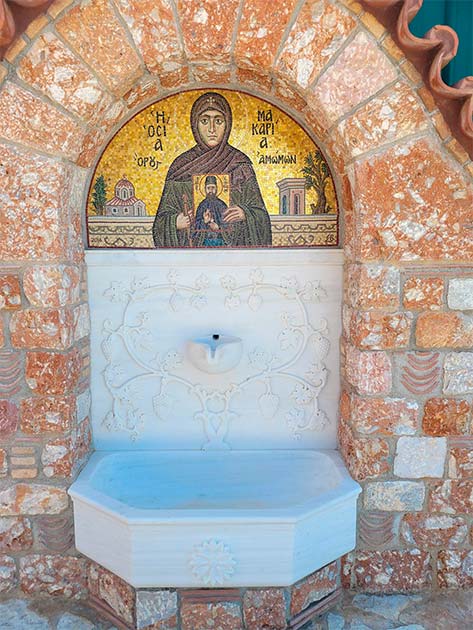
A mosaic above a water fountain depicts Sister Makaria holding an image of Saint Ephraim. Photo: Joanna Gillan
Modern Celebrations and Significance
The echoes of the past reverberate in the present-day activities and celebrations at the monastery. On January 3rd, a grand commemoration marks the discovery of Saint Ephraim's relics. This event sees a confluence of devotees not just from Greece but from far and wide. They gather to honor the legacy of Saint Ephraim, participating in rituals and seeking blessings.
Visitors to the Saint Ephraim Monastery are greeted by a remarkable blend of ancient and restored architecture. The stone walls, punctuated by arched windows and doorways, give way to the intricate dome, a characteristic feature of traditional Eastern Orthodox churches. Surrounding the main building are meticulously landscaped gardens, dotted with religious statues and shrines, providing a serene backdrop for contemplation. A particularly haunting yet revered feature of the grounds is the old mulberry tree from which Saint Ephraim met his tragic fate, standing as a solemn reminder of the monastery's tumultuous history.
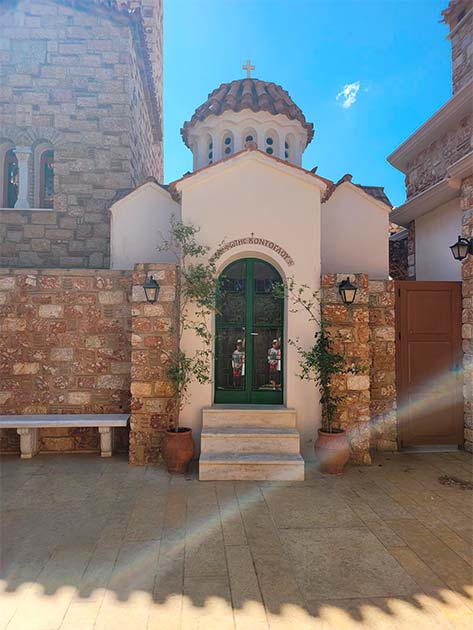
Saint Ephraim Monastery, Nea Makri, Greece. Photo: Joanna Gillan
Inside the monastery, the walls are adorned with vibrant frescoes depicting biblical scenes and important figures from Orthodox Christian history. Gilded chandeliers hang from the vaulted ceilings, casting a gentle light that enhances the rich hues of the paintings and the polished marble floor. The focal point of the interior remains the niche that houses the relics of Saint Ephraim. Encased in ornate, protective glass, these holy remnants are a beacon, drawing in countless devotees who come to pay their respects and seek spiritual solace.
Top image: Saint Ephraim Monastery, Nea Makri, Greece. Photo: Joanna Gillan
References
Holy Monastery of Saint Ephraim – Nea Makri, Attica. Monacthria Tis Elladas. Available from: https://www.monastiria.gr/holy-monastery-of-saint-eufraim-nea-makri-attica/?lang=en
The Life and Miracles of St Ephraim of Nea Makri. Christianity Spiritual Artworks. Available from: https://www.christianityart.com/blogs/blog/the-life-and-miracles-of-st-ephraim-of-nea-makri
St Ephraim of Nea Makri – A beautiful Greek Orthodox Monastery. Templeseeker. Available from: https://www.templeseeker.com/st-ephraim-of-nea-makri-greek-orthodox-monastery/
















